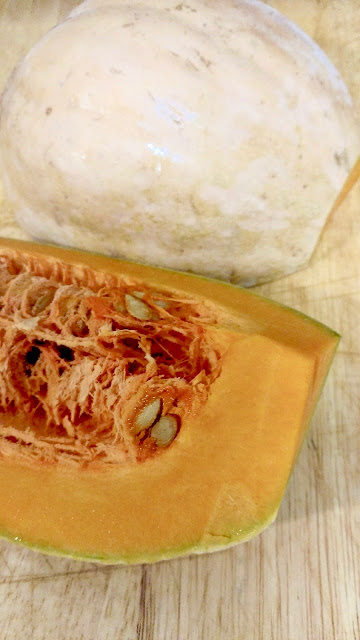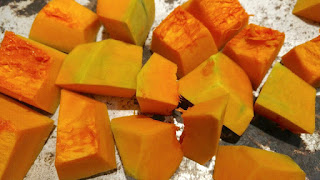
Recipe: Winter (mystery) squash looks challenging, but results are versatile and delicious

Weird on the outside, delicious on the inside:
Crazy squash. (Photos: Debbie Arrington) |
It’s time to tackle the crazy squash.
The last of the fall harvest can linger for months. (That’s why pumpkins make such great decorations.) Hard-shelled squash will keep without refrigeration for weeks. That’s why they’re nicknamed “winter squash”; you can eat them “fresh” from October through March (or longer).
But some winter squash can be a formidable challenge. First, what is it? Like all members of the squash and pumpkin family, these plants can easily cross, creating mysterious hybrids.
That’s how I ended up with a bunch of crazy squash. From the outside, they looked sort of like banana squash, but not quite as big (thankfully). Maybe they had papaya squash or more likely butternut squash in their parentage; their size and shape reminded me of a football, only rounder. (A rugby ball, perhaps?)
Their insides, once cooked, tasted like pumpkin. So that made these squash crazy versatile, too. They can go savory or sweet.
So how do you approach a football-size mystery? First, wash the skin well, scrubbing off any accumulated grime. With a long sharp knife on a firm cutting surface, cut in half, then quarters. That makes it easier to scrape out the seeds.
After seeding, peel the skin and cut the flesh into 1-inch chunks. Those chunks can be steamed; they’ll be tender in about 20 to 30 minutes. The cooked flesh can be mashed and used in any pumpkin recipe such as pumpkin bread, soup or cookies.
Those chunks also make a great side dish on their own by simply roasting. They make a tasty (and vitamin-packed) accompaniment to hearty winter meals that’s crazy good for you, too. Who knew you could enjoy “garden-fresh” fresh squash in February?
Roasted crazy squash
Serves 4 to 6

Steam the chunks and mash to use in recipes
as you would with pumpkin. Or roast them. |
Ingredients:
Comments
0 comments have been posted.Sacramento Digs Gardening to your inbox.
Sites We Like
Garden Checklist for week of May 5
Survey your garden after the May 4 rainstorm. Heavy rain and gusty winds can break the neck of large flowers such as roses. Also:
* Keep an eye on new transplants or seedlings; they could take a pounding from the rain.
* Watch out for powdery mildew. Warmth following moist conditions can cause this fungal disease to “bloom,” too. If you see a leaf that looks like it’s dusted with powdered sugar, snip it off.
* After the storm, start setting out tomato transplants, but wait on the peppers and eggplants (they want warmer nights). Pinch off any flowers on new transplants to make them concentrate on establishing roots instead of setting premature fruit.
* Trim dead flowers but not leaves from spring-flowering bulbs such as daffodils and tulips. Those leaves gather energy to create next year's flowers. Also, give the bulbs a fertilizer boost after bloom.
* Pinch chrysanthemums back to 12 inches for fall flowers. Cut old stems to the ground.
* Mulch around plants to conserve moisture and control weeds.
* From seed, plant beans, beets, cantaloupes, carrots, corn, cucumbers, melons, pumpkins, radishes and squash.
* Plant onion sets.
* In the flower garden, plant seeds for asters, cosmos, celosia, marigolds, salvia, sunflowers and zinnias. Transplant petunias, zinnias, geraniums and other summer bloomers.
* Plant perennials and dahlia tubers for summer bloom.
* Don’t wait; plant summer bulbs, such as gladiolus and tuberous begonias.
* Harvest cabbage, lettuce, peas and green onions.